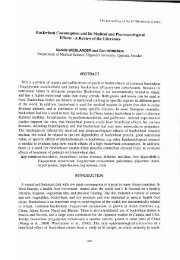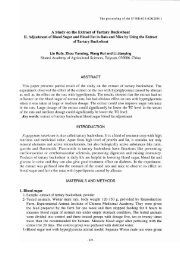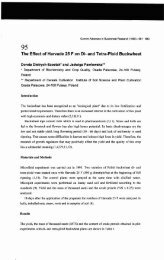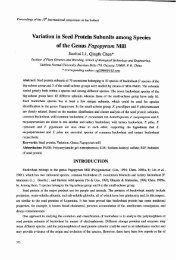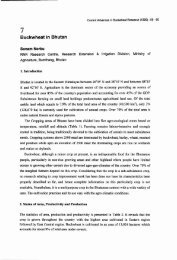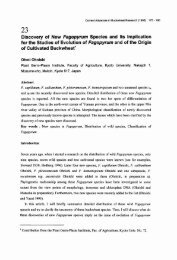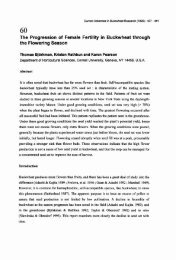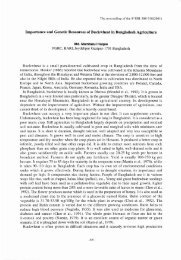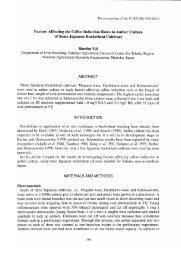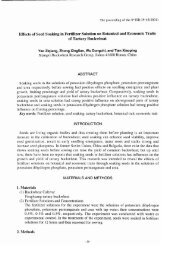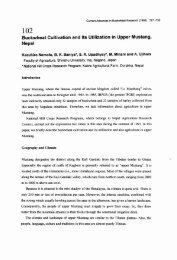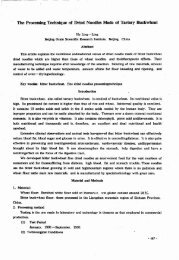40. Studies on Chromosomes Doubling of Tartary Buckwheat
40. Studies on Chromosomes Doubling of Tartary Buckwheat
40. Studies on Chromosomes Doubling of Tartary Buckwheat
Create successful ePaper yourself
Turn your PDF publications into a flip-book with our unique Google optimized e-Paper software.
315<br />
to the seeds from 'the parent stock (c<strong>on</strong>trast) (see Table 2). After eXaminati<strong>on</strong> 'under a<br />
microscope, it was found that the number <strong>of</strong> chromosomes in the root tip cell <strong>of</strong>the'largerseed<br />
was 2n = 4x = 32. It was autotetraploid. The number <strong>of</strong>chromosomes in. the root tip cell <strong>of</strong>the<br />
small seed <strong>on</strong> both the parent stock and the mosaic was 2n = 2x = 16. They were diploids (see<br />
Picture I, II)<br />
Table I. Survival rate and chromosomes-doubling <strong>of</strong>different plants.<br />
Variety Treated No. Survived No. Dead No, Successfully- <strong>Doubling</strong>-Rate Treatment Effect<br />
Doubled No.<br />
Eluowuqie 160 107 23 64 59.81 -<str<strong>on</strong>g>40.</str<strong>on</strong>g>00<br />
Shichee 160 121 29 76 62.81 47.50<br />
Kuochiqiao 160 110 34 61 55.45 38.13<br />
Note: Any plant from which more than <strong>on</strong>e doubled seed was harvested means that the plant was successfully doubled.<br />
<strong>Doubling</strong> Rate = Successfully doubled No. I Survived No,<br />
Treatment Effect =Successfully doubled No, I Treated No,<br />
Table 2. A comparis<strong>on</strong> <strong>on</strong> flower and seed between doubled plants and CK plants.<br />
Variety Corolla Dia. (mm) Seed L.x W. (mm),<br />
Eluowuqie diploid (CK) 3.29 5.2 x 3.7<br />
Eluowuqie mosaic 2x 3.27 5.4 x 3.6<br />
4x 4.41 6.9 x4,9<br />
Shichee diploid (CK) 3.38 5.8 x 3.2<br />
Shichee mosaic 2x 3.34 5.7 x 3.0<br />
4x 4.75 7.9 x 3.6<br />
Kuciquiao diploid (CK) 3.16 5.0 x 4.7<br />
Kuciquiao mosaic 2x 3.17 4.8 x 4.6<br />
4x 4.59 7.1 x 5.9<br />
2. Main Characteristics <strong>of</strong>the Tetraploid <strong>Tartary</strong> <strong>Buckwheat</strong><br />
Compared with the diploid parent stock (CK), the tetraploid has a taller plant, thicker stalk,<br />
many shoots <strong>on</strong> the main stalk. less leaves but larger in size. The seed-forming rates <strong>of</strong> aU the<br />
tetraploid tartary buckwheat are decreased. The average seed-f<strong>on</strong>ning rate <strong>of</strong> Eluowuqie<br />
tetraploid is 24.12%, 16.05% less than the c<strong>on</strong>trast rate 28.73%. The average seed-f<strong>on</strong>ni!1g rate<br />
<strong>of</strong> Shichee tetraploid is 27.1%, 10.56% less than the c<strong>on</strong>trast rate. However, what merits<br />
attenti<strong>on</strong>. is that, because <strong>of</strong> the smaller fJowers <strong>of</strong> the single plant <strong>of</strong> tetraplo.id tartary<br />
buckwheat being notably increased (about 30-50%), its seeds from a single plant are still more<br />
than that from diploid parent stock. In additi<strong>on</strong>, the se~ds <strong>of</strong> tetraploid' tartary buckwheat are<br />
remarkably enlarged. Thus the yield <strong>of</strong>a single plant is higher than that <strong>of</strong> diploid tartary<br />
buckwheat (see Table 3).




